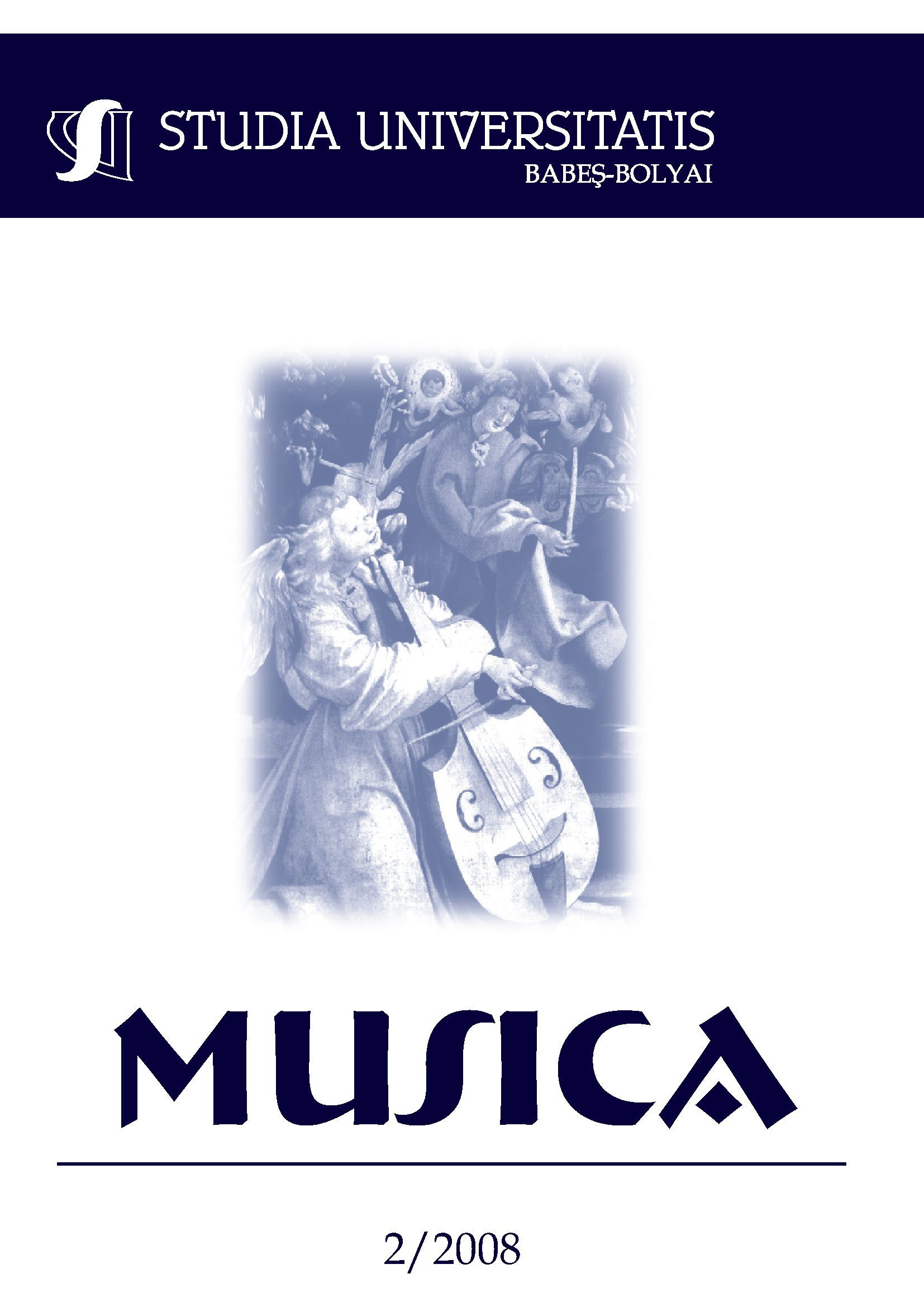LIGETI’S “STRING QUARTET No.1”; STYLISTIC INCONGRUENCE?
Keywords:
string, quartet, Ligeti, characteristics, arch, form, structure, variation, chromatics, diatonicAbstract
Compared to Ligeti’s String Quartet no.2, Métamorphoses nocturnes is a piece that has been less explored, although it towers over the author’s early creations. Using a sole melodic motif extracted from Bartók’s piano piece Klänge der Nacht, the Quartet develops a set of syntactic and language characteristics that confer this Budapest period work a reverential gesture to Ligeti’s outstanding predecessor. The arch form structure, the continuous variation technique, the fusion between chromaticism and diatonicism, they all highlight a compelling interconnection with Bartók’s universe. Our emphasis on the stylistic incongruence concept emerges from the contrast between the five constitutive sections of the arch form and the coda segment. Whilst the constant transformation technique of the generative motif in all five sections polarizes titles such as Musica Ricercata, Sechs Bagatellen für Bläserquintett, the coda conceals a stylistic border zone and prefaces an irreversible evolution process towards significant works of the next decade – Glissandi, Apparitions, Athmosphères. It leads directly to the meta-language of sonorous fields and static blocks projected beyond any gravitational space, where musical parameters dissolve in a unique one: the timbre colour. In the coda segment, Ligeti operates a complete suspension of the temporal dimension and induces a sonorous entropy. These new elements will trigger in future works the structural collapse and the disintegration of the articulated form, which will become noteworthy stilemas of his later creation. The title’s declared metamorphosis required a multi-level semantic decoding, but the analysis finally provided all the arguments in order to consider String Quartet no.1 synonymous with Ligeti’s definitive stylistic conversion.
References
Beckless Willson, Rachael, Ligeti, Kurtág and Hungarian Music during the Cold War, Cambridge University Press, 2007.
Bernard, Jonathan W., Ligeti’s restoration of interval and its significance for his later works, in: Music Theory Spectrum, Bloomington Ind., vol.21 nr.1, 1999.
Burde, Wolfgang, György Ligeti – Eine Monographie, Atlantis-MusikbuchVerlag, Zürich, 1993.
Busan, Robert, György Ligeti’s“Musica ricercata” and ”Six Bagatelles“ for wind quintet; A study in transcription or recomposition?, Ann Arbor, Michigan, UMI, 2006.
Cojocaru, Dora, Creaţia lui György Ligeti în contextul stilistic al secolului XX (György Ligeti’s Creation in the Stylistic Context of the 20th century), Editura Media Musica, Cluj-Napoca, 1999.
Cojocaru, Dora, Ligeti şi noua modernitate (Ligeti and the New Modernity), in: Rev. Muzica, an IX, nr.3 (35), UCMR Bucureşti,1998, p. 14 – 35.
Dibelius, Ulrich, Moderne Musik, vol.I-II, Piper/Schott Verlag, München/Mainz, 1991.
Floros, Constantin, Versuch über Ligetis jungste Werke, in: Für Gy. Ligeti – Die Referate des Ligeti Kongress Hamburg 1988, Hamburger Jahrbuch für Musikwissenschaft 11, Laaber Verlag, 1991.
Hicks, Michael, Interval and Form in Ligeti’s Continuum and Coulée, in: Perspectives of new music, vol.31/1993, p.172 - 190.
Kreinin, Yulia, To arrest the process: moving clusters by György Ligeti and Witold Lutoslawski, in: Mitteilungen der Paul Sacher Stiftung, nr.5/2002, Basel, p. 36 - 41.
Kyburz, Hanspeter, Fondaments d’une interprétation: la construction numérique dans le Deuxième Quator de Ligeti, in: Ligeti – Kurtág, Ed. L’Âge de l’Homme, Paris, 1990, p. 133 - 152.
László, Ferenc, Ligeti a hídon. A Musica ricercata és a Hat bagatelle: az exodus zenéi (Ligeti on the Bridge. Musica ricercata and the Six Bagatelles: the Exode Music) in: Magyar zene, XLI. évfolyam, 4. szám, nov., 2003.
László, Francisc, Strategii modale în „Şase bagatele pentru cvintet de suflători“ de György Ligeti (Modal Strategies in „Six Bagatelles for Wind Quintet” , in: Rev. Muzica, an X, nr.2 (38), UCMR Bucureşti, 1999.
Lewin, David, Generalized Musical Intervals and Transformations, New Haven, Yale University Press, 1987.
Lewin, David, Musical Form and Transformation: 4 Analytic Essays, New Haven, Yale University Press, 1993.
Ligeti, György, Gesammelte Schriften herausgegeben von Monika Lichtenfeld, Band 2, Schott Music GmbH & Co. KG, Mainz, 2007.
Ligeti, György, Wandlungen der musikalischen Form, in: Rev. Die Reihe, nr.7/ 1960, Universal Edition, Viena, p. 5 - 17
Ligeti, György und Harald Kaufmann, Wenn man heute ein Streichquartett schreibt/ NMZ, Schott´s Sohne, Mainz, 1970/7, 8.
Michel, Pierre, György Ligeti, Ed. Minerve, Paris, 1995.
Michel, Pierre, Die Sechs Bagatellen für Bläserquintett von György Ligeti und ihre musikalische Substanz in vergleich mit Musica ricercata und seinen Weken der folgende Perioden, in: Zwischen Volks und Kunstmusik, Pfau Verlag, Saarbrucken, 1999, p.155 - 161.
Niculescu, Ştefan, Reflecţii despre muzică (Reflections on Music), Editura Muzicală, Bucureşti, 1980.
Nordwall, Ove, György Ligeti. Eine Monographie. B. Schott‘s Söhne, Mainz, 1971.
Pardo Salgado, Carmen, Imagen y medida de un espacio sonoro: G. Ligeti y K. Stockhausen, in: Revista de Musicologia, vol.21/1998, Madrid, p. 79 - 92.
Power, Richard, An analysis of transformation procedures in György Ligeti’s String Quartet no.2, Ann Arbor, Michigan, UMI, 1997.
Rülke, Volker, Die undendliche Säule: Überlegungen zum Verhältnis von Musik und bildener Kunst anhand zweiter Werke von Constantin Brâncuşi und György Ligeti, in: Musikalisches Festland, von Bockel Verlag, Hamburg, 1997, p.143-154.
Sallis, Friedemann, Observations sur le développement technique et stylistique de György Ligeti au début des années 1950, in: Canadian University Music Review, 16/2, 1996, p. 44 – 65.
Sallis, Friedemann, Catalogue of György Ligeti’s Early Works (1938-1956), in: author’s volum: An introduction to the early works of György Ligeti, Köln: Studio, 1996, p. 262 – 291.
Simms, Bryan, R., Music of the Twentieth Century. Style and Structure, Ed. Schrimer, Belmont, 1996.
Várnai, Péter, Beszélgetések Ligeti Györggyel (Conversations with György Ligeti), Zeneműkiadó, Budapest, 1979.
Vázquez, Herbert, Análisis del Studio 1 para piano, ‘Désordre’, de György Ligeti, in: Fundamentos teóricos de la música atonal, Dirección general de Publicaciones y fomento editorial, México, 2006, p. 391 – 429.
Downloads
Published
How to Cite
Issue
Section
License
Copyright (c) 2008 Studia Universitatis Babeș-Bolyai Musica

This work is licensed under a Creative Commons Attribution-NonCommercial-NoDerivatives 4.0 International License.



